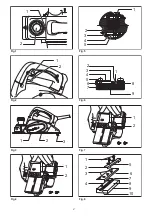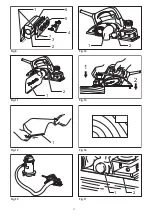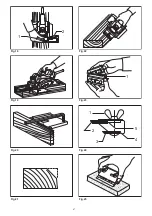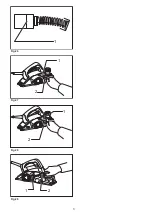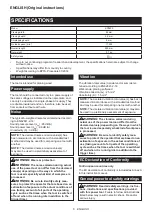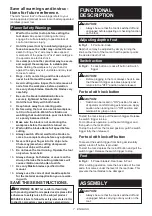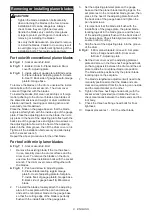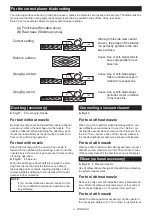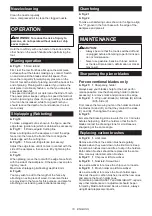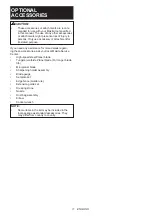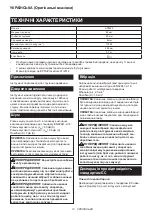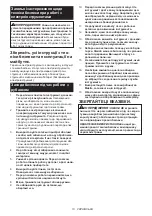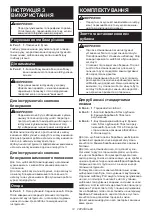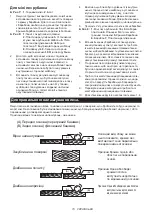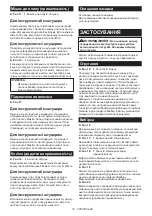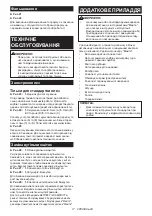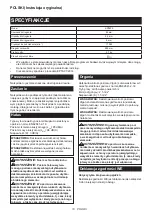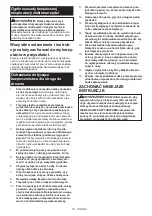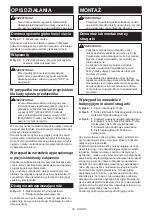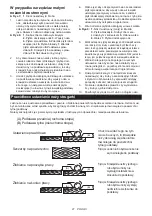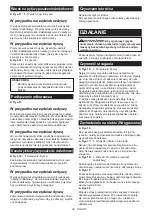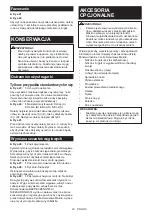
8 ENGLISH
Removing or installing planer blades
CAUTION:
•
Tighten the blade installation bolts carefully
when attaching the blades to the tool. A loose
installation bolt can be dangerous. Always
check to see they are tightened securely.
•
Handle the blades very carefully. Use gloves
or rags to protect your fingers or hands when
removing or installing the blades.
•
Use only the Makita wrench provided to remove
or install the blades. Failure to do so may result
in overtightening or insufficient tightening of the
installation bolts. This could cause an injury.
For tool with conventional planer blades
►
Fig.4:
1.
Socket wrench
2.
Bolt
►
Fig.5:
1.
Bolts
2.
Drum
3.
Planer blade
4.
Drum
cover
5.
Adjusting plate
►
Fig.6:
1.
Inside edge of gauge plate
2.
Blade edge
3.
Planer blade
4.
Adjusting plate
5.
Screws
6.
Heel
7.
Back side of gauge base
8.
Gauge
plate
9.
Gauge base
To remove the blades on the drum, unscrew the instal
-
lation bolts with the socket wrench. The drum cover
comes off together with the blades.
To install the blades, first clean out all chips or foreign
matter adhering to the drum or blades. Use blades of
the same dimensions and weight, or drum oscillation/
vibration will result, causing poor planing action and,
eventually, tool breakdown.
Place the blade on the gauge base so that the blade
edge is perfectly flush with the inside edge of the gauge
plate. Place the adjusting plate on the blade, then sim
-
ply press in the heel of the adjusting plate flush with the
back side of the gauge base and tighten two screws on
the adjusting plate. Now slip the heel of the adjusting
plate into the drum groove, then fit the drum cover on it.
Tighten all the installation bolts evenly and alternately
with the socket wrench.
Repeat the above procedures for the other blade.
For tool with mini planer blades
►
Fig.7:
1.
Socket wrench
2.
Bolt
1. Remove the existing blade, if the tool has been
in use, carefully clean the drum surfaces and the
drum cover. To remove the blades on the drum,
unscrew the three installation bolts with the socket
wrench. The drum cover comes off together with
the blades.
►
Fig.8:
1.
Pan head screw
2.
Adjusting plate
3.
Planer blade locating lugs
4.
Gauge
plate
5.
Heel of adjusting plate
6.
Set plate
7.
Inside flank of gauge plate
8.
Gauge base
9.
Back side of gauge base
10.
Mini planer
blade
2. To install the blades, loosely attach the adjusting
plate to the set plate with the pan head screws
and set the mini planer blade on the gauge base
so that the cutting edge of the blade is perfectly
flush with the inside flank of the gauge plate.
3. Set the adjusting plate/set plate on the gauge
base so that the planer blade locating lugs on the
set plate rest in the mini planer blade groove, then
press in the heel of the adjusting plate flush with
the back side of the gauge base and tighten the
pan head screws.
4. It is important that the blade sits flush with the
inside flank of the gauge plate, the planer blade
locating lugs sit in the blade groove and the heel
of the adjusting plate is flush with the back side of
the gauge base. Check this alignment carefully to
ensure uniform cutting.
5. Slip the heel of the adjusting plate into the groove
of the drum.
►
Fig.9:
1.
Mini planer blade
2.
Groove
3.
Set plate
4.
Hex. flange head bolts
5.
Drum cover
6.
Drum
7.
Adjusting plate
6. Set the drum cover over the adjusting plate/set
plate and screw in the three hex flange head bolts
so that a gap exists between the drum and the set
plate to slide the mini planer blade into position.
The blade will be positioned by the planer blade
locating lugs on the set plate.
7. The blade's lengthwise adjustment will need to be
manually positioned so that the blade ends are
clear and equidistant from the housing on one side
and the metal bracket on the other.
8. Tighten the three hex flange head bolts (with the
socket wrench provided) and rotate the drum to
check clearances between the blade ends and the
tool body.
9. Check the three hex flange head bolts for final
tightness.
10. Repeat procedures 1 - 9 for the other blade.


